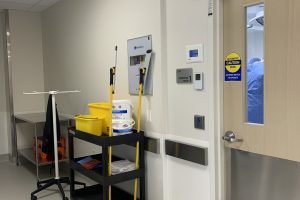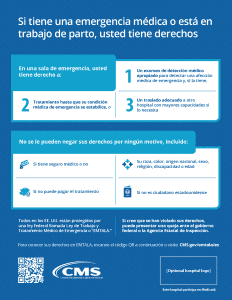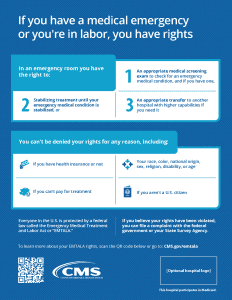September 2024
Inside This Issue
September has arrived, memories of summer vacation seem more distant, schools are back in session and it’s time to refocus until we are again distracted in a few more months by the holiday season. The content in this month’s issue of Perspectives remains somewhat light, so this may be a good time to tackle some older and difficult items on your to do list as there is not a lot of new content to worry about.
 Certification Programs:
Certification Programs:
Those of you who have chosen to achieve one or more of The Joint Commission’s optional certification programs will want to read the article on “elimination of some elements of performance.” We have seen Joint Commission promote this same concept in its accreditation programs over the last few years, but much of those modifications were actually consolidation of more than one element of performance into a compound element of performance with multiple expectations.
Perspectives touts that “57% of the elements of performance have been eliminated.” The prepublication page, posted at this time on the Joint Commission website contains the DSC standards, but not the revised elements of performance. The Perspectives article states that a detailed version with the EPs will be posted to each certified organizations extranet page, but upon looking at some client extranet sites, that does not yet appear to be present as we are writing this newsletter.
If you are certified, do be on the lookout for the complete version which should be posted fairly soon. This will require some study to determine what if any requirements are actually eliminated and which requirements remain in a reformatted, compound element of performance.
 Get With the Guidelines (GWTG) Upload:
Get With the Guidelines (GWTG) Upload:
Perspectives has a reminder article for hospitals with Advanced Stroke Certification programs that functionality exists that would enable a data transfer from the American Heart Association’s GWTG registry to The Joint Commission’s certification measure database. This had previously been discussed in the April 2024 issue of Perspectives and at this time 25% of advanced stroke programs have chosen to enable this data transfer.
The September issue of Perspectives contains a link to a permission form and questionnaire to start the ball rolling if you are interested. Perspectives also indicates that this functionality can be used for data transfer for Advanced DSC programs for coronary artery disease including Acute Heart Attack Ready (AHAR), Comprehensive Heart Attack Center (CHAC), and Primary Heart Attack Center (PHAC).
 The Consent Process:
The Consent Process:
This month’s Consistent Interpretation column discusses RI.01.03.01, EPs 1 and 2 relative to the consent process. TJC indicates that the hospital noncompliance rate for EP 1 in 2023 was just under 30% and EP 2 was a little more than 4%.
EP 1 establishes requirements for the organization’s policy on informed consent which must describe which services require informed consent, the circumstances when informed consent can be waived, the process used to obtain informed consent, who is authorized to perform the informed consent discussion in accordance with law and regulation, and how informed consent is to be documented in the medical record.
EP 2 requires the informed consent process to include a discussion of the planned treatment and the risks, benefits and alternatives to that planned treatment.
As is customary with this monthly article, TJC includes some surveyor observations as well as a guidance/interpretation section which provides detailed scoring advice to surveyors. This section contains guidance on scoring the new CMS requirement described in QSO 24-10 relative to clinical students performing intimate/sensitive examinations for teaching purposes, or such students performing services/portions of a procedure.
This guidance is important to know for new surveys going forward but is not reflective of reasons why these elements of performance were scored in 2023 surveys as the CMS requirement had not yet been established until 2024. In addition, some, or all, of the surveyor observations are likely hypothetical as this specific issue would not have been scored in 2023.
Nevertheless, the guidance section does provide insight on the additional expectations for EP 1, the policy EP. The hospital policy must detail the organizations expectations for informed consent discussion and documentation for procedures involving anesthesia and procedures not involving anesthesia if a student is going to perform any services or one of these sensitive/intimate examinations or invasive procedure.
Per CMS and TJC, such procedures which include anesthesia must include a documented patient consent form, whereas procedures without anesthesia could be documented by an authorized provider in a progress note. The guidance section for EP 1 also provides examples of what “portions of a procedure” might include as well as what constitutes an intimate/sensitive examination.
Do take a look at the Consistent Interpretation column and verify that your policies and procedures include this new expectation and consider what training has been provided to staff, providers and clinical teaching affiliates on this new expectation. You may also want to audit some medical records to verify compliance with this evolving requirement.
 Workplace Violence Standards:
Workplace Violence Standards:
The lead article in this month’s EC News is a reminder that the TJC workplace violence standards become effective for accredited home care agencies as of January 1, 2025. The article also includes a quick refresher on some of the content expectations for this new set of standards.
Workplace Violence Prevention:
There is a second and more detailed article describing the implementation and refinement of the workplace violence prevention program at Maine Medical Center. While the target audience for these first two articles may be different accreditation programs, home care agencies that are still developing their program for 2025 may find the description of the implementation and improvement effort at this hospital informative.

Additionally, hospital readers will find some good ideas for their own organizations in the discussion from Maine Medical Center. The authors describe their improvement in reported WPV incidents going from an average of 423 per month in 2022 down to 175 per month in 2024. One of the things they did was to incorporate training from the Crisis Prevention Institute to de-escalate potential violent incidents and the depth of training was tailored to the nature of the staff and each work area.
The State of Maine had a very significant mass shooting in 2023 with 18 killed and another 13 wounded, some of whom came to MMC for treatment, so they added active shooter training as part of their workplace violence program. This training included the traditional run-hide-fight logic, but was individualized to actually conduct the training in different work areas so staff could think through how and where they would run, hide, or fight.
In addition, they added more cameras and two-way vision windows in doors. Visitor identification was also modified to include a photo of the visitor on the printed ID badge along with a location that was to be visited. That way if the individual showed up at a different location, they could redirect them or inquire about why they were present or call security if suspicion was heightened. Their WPV program also included new design considerations to ensure that greeting staff were positioned to see new arrivals approaching and included panic buttons to bring security if needed.
Lastly, they also discussed the different ways that staff used to report incidents of WPV, which are now all funneled into the main incident reporting mechanism to promote ease of tracking and analysis. There are lots of good ideas for consideration at your own organization that may be useful to program refinement.
 Training on De-escalation:
Training on De-escalation:
Continuing the theme on workplace violence (WPV) prevention this month’s EC News has a one-page refresher on de-escalation to prevent WPV. This article links back to a January 2019 issue of The Joint Commission’s publication called Quick Safety, Issue #47, which provided detailed information on de-escalation and patient assessment tools for predicting potential violence. A link is provided to this specific Quick Safety in EC News and with turnover in staff it would be well worth sharing with your WPV team to revisit the suggestions.
There are four specific patient assessment tools suggested including the:
- STAMP: Staring, Tone/volume, Anxiety, Mumbling, Pacing
- OAS: Overt Aggression Scale
- BVC: Broset Violence Checklist
- BRACHA: Brief Rating Aggression Children and Adolescents
There is also a description of different clinical models of de-escalation, as well as potential interventions to defuse aggression. Lastly there is an extensive reference list which may be useful if you want to implement some of these recommendations.
ITM of Medical Gas Systems and Shutoff Valves:
This month’s EC News Q+A section discusses inspection, testing, and maintenance (ITM) and medical gas shut off valve requirements. This is particularly helpful in providing a simplified explanation of some of the basic requirements for your medical gas systems. For example, they describe that medical gas piping is prohibited from being painted but does require specific labeling and color coding to describe what gas is contained in the pipe.
There is also a reminder about not blocking access to medical gas shut off valves. As consultants we would add a reminder to this issue that blocking access is a very common finding. We believe that staff may be viewing the shut off panel and see that it is not blocked or obscured, however the requirement means nothing whatsoever is parked in front of the space where the shut off valve is located, regardless of height. Garbage cans, tables, printers, rolling carts, etc. cannot be there. You want to think of those medical gas shut off valves as “No Parking Zones” and in fact we have seen organizations paint the floor in front of the medical gas shut off valve as a reminder.
 Workplace Violence Response Process:
Workplace Violence Response Process:
In mid-August, TJC published their bimonthly issue of Emergency Management Leader. Continuing the WPV theme there is an article from Cincinnati Medical Center describing an actual workplace shooting incident they had in their psychiatric emergency area. The authors describe the rapid response of local police who were stationed elsewhere at the hospital and the fortunate survival of their unarmed security guard who was shot by the intruder.
Most important for our readers is that although there was a perceived successful outcome, the organization critiqued the incident and identified opportunities for improvement to strengthen their active shooter response going forward. They obtained more armed municipal police officers to support hospital security guards, refined their crisis communications plan, joined an Ohio Multi-Agency Radio Communications System (MARCS) to improve communication between hospital and police authorities and participated in expanding training on the “Stop the Bleed” campaign to train staff on the techniques to stop bleeding including the use of tourniquets.
They also augmented their security process in the psychiatric emergency area by including a package scanner and implementation of a sally port, two door interlock system to gain entry. For those of you who are either just implementing your WPV program or are looking for ideas to improve your existing program, there are some great ideas from an organization that experienced an actual shooting incident.
Disaster Supplies:
The August EM Leader has an article on a tool created by the HHS ASPR-TRACIE, or Administration for Strategic Preparedness – Technical Resource Assistance Center that can help hospitals plan for required disaster resources that might be needed for a significant disaster. This is called the DASH tool and can be found at https://dashtool.org
 There are 4 specific modules developed:
There are 4 specific modules developed:
- Hospital Pharmacy
- PPE
- Burn Supplies
- Trauma Supplies
Each spreadsheet type tool bases resource estimates on information about your hospital including its size, services and role in the community, to help guide the estimate. This is particularly helpful because it puts some science behind the resource estimates. As consultants one of the issues, we sometimes see is that there is a resource plan, but the science or logic behind the estimates is not present.
We suggest that this article be shared with your EM team and the Dashtool be utilized to compare and analyze any existing estimates you might have for such emergency supplies.
 Wildfire Exercise:
Wildfire Exercise:
As summer draws to a close the continued risk of wildfires will begin to lessen but in preparation for next summer EM Leader also contains a very useful article describing resources developed by JCR including a Word based wildfire table top exercise and a PowerPoint based drill scenario. These tools can be used to perform a tabletop exercise to help think through the implications for your organization should there be a wildfire in your area and to improve your state of readiness.
![]()
ACHC: Infection Prevention in Surgery Webinar
ACHC has a webinar coming up this month on Infection Prevention in Surgery. This is scheduled for September 19th at 12 noon eastern daylight time. If interested you can sign up using the following link: ACHC webinar on Infection Prevention in Surgery September 19 Noon EST
![]() CIHQ: Accreditation and Regulatory Summit
CIHQ: Accreditation and Regulatory Summit
The annual CIHQ Summit is scheduled for September 24-26 in San Antonio Texas. Their agenda includes topics on CMS, QAPI, survey readiness, systems improvement agreements, EMTALA, medication safety and more. If interested, they have quite an extensive list of expert presenters which can be viewed using the following link: https://cihq.org/corp-summit-speakers.asp We will have a booth at this conference, so please stop by if you are attending!
Some readers may be pleased to know that not everyone in Washington took vacation in August. CMS issued 3 new QSO memos. One is directed to organ procurement organizations, one to physical therapy and speech language pathology providers and one to hospitals regarding EMTALA signage.

 New EMTALA Sign:
New EMTALA Sign:
The first of the August QSO memos is QSO 24-17 issued August 13, 2024 discusses new EMTALA signage and includes a link to a CMS developed sign, available in both English and Spanish that can be downloaded from https://www.cms.gov/files/document/emtala-poster-participating-medicaid-english.pdf
Such signage must be placed where it will be seen by all individuals entering the emergency department, as well as by all individuals waiting for examination and treatment. If you choose not to use the CMS developed signage, your sign must be clear and in simple terms and language understandable by the population served.
Extension Site Locations:
The second was QSO 24-18 issued 8/23/24 and is directed to physical therapy providers, speech language pathology providers, and to accrediting bodies. The memo provides guidance to CMS and accreditors on sites to visit and what accreditors should do when existing accredited providers want to add new site locations.
 The memo addresses four issues:
The memo addresses four issues:
- Primary and extension site surveys
- Surveying all or a sample of extension sites
- Surveying all CoPs or a subset at extension locations
- Extension sites greater than 30 miles away, or across state lines
In regards to an existing CMS approved provider requesting addition of a new extension site, CMS will require the organization to submit a form 855 plus a CMS form 381 to the Medicare Administrative Contractor (MAC) in that area. The MAC will determine if the new site should be approved for addition to the primary site. Next, CMS and accrediting bodies may decide upon the need for an extension survey using the following criteria:
- Review of survey history and non-compliance of the primary site
- Number of substantiated complaints against the primary site
- Number of total extension sites already approved, as applicable
- Services being offered
- Size and geographic location of the extension site (same service population).
On the issue of the need to survey all extension locations on a resurvey of an existing accredited or Medicare certified provider, CMS is removing the prior mandate to survey all sites and authorizing the accreditor or state agency to make a determination on the need for surveying all or a representative sample of extension sites. However, for an initial survey the state agency or accreditor must survey all sites.
In regard to the need to survey all CoPs at extension locations the answer is yes, but also no. An organization must meet all CoPs but some issues such as governing body, personnel policies, patient care policies, and emergency preparedness don’t need to be independently evaluated at each site. However, CMS states that surveyors must evaluate the following CoPs. at each care site:
- 485.711 Condition of Participation: Plan of Care and Physician Involvement
- 485.713 Condition of Participation: Physical Therapy Services
- 485.715 Condition of Participation: Speech Pathology Services
- 485.721 Condition of Participation: Clinical Records
- 485.723 Condition of Participation: Physical Environment
- 485.725 Condition of Participation: Infection Control
On the issue of a 30-mile radius between the main site and extension sites, CMS indicates that they will continue to permit extension sites beyond 30 miles so long as the main site is actually providing direction to the extension sites, and they serve generally the same patient population. There is an element of subjectivity here in that state agencies or accreditors will need to evaluate the degree of main site oversight by reviewing data such as organization charts, supervisory visit frequency to the remote site, documentation of staff meetings, and QAPI data. Extension sites that are in a different but adjoining state will be evaluated even more rigorously prior to approval.
 Pancreata Reporting Requirements:
Pancreata Reporting Requirements:
The last CMS memo issued on August 29 is QSO 24-19 which discusses organ procurement organization reporting requirements for pancreata. CMS has identified new codes to document pancreata obtained for islet cell and non-islet cell research purposes as well as pancreata obtained for transplant, but ultimately not transplanted, but sent for islet cell or non-islet cell research. We also noted that CMS wants reclassification of older data and a resubmission of previously submitted OPN data. Organizations with an OPN will want to read this one carefully as there is a short turnaround time to resubmit this data once requested.
 Initial Accreditation Requirements for Home Health & Hospice:
Initial Accreditation Requirements for Home Health & Hospice:
CMS also revised an Administrative Memorandum 24-22 on August 23, 2024, that is not really addressed to providers, although it will affect them, but rather to CMS regional offices, contractors and accrediting bodies. This memo had previously been issued in 2021, 2023, and again this August. The newest revision eliminates the ability for accrediting bodies to accredit new (initial) home health agencies and hospice organizations until CMS has given the green light to authorize the accrediting body to conduct a survey. This administrative memo is mentioned in the QSO for physical therapy and speech language pathology providers and can be found at: https://www.cms.gov/files/document/admin-info-24-22-all-revised-8-23-24.pdf
Consultant Corner
Dear Readers,
 We appreciate all who participated in the vacation or work-away-from-home photo contest! It was wonderful to see all the unique, beautiful, and vast places people have been this year – Hawaii, Puerto Rico, Colorado, Arizona, South Carolina, Tennessee, Wisconsin to name a few.
We appreciate all who participated in the vacation or work-away-from-home photo contest! It was wonderful to see all the unique, beautiful, and vast places people have been this year – Hawaii, Puerto Rico, Colorado, Arizona, South Carolina, Tennessee, Wisconsin to name a few.
Upon random selection, the winning photo this year came from the Navajo Nation near Fort Defiance in Arizona. Some Patton goodies are heading to Jayne S. in Waukesha, WI! Thanks, Jayne, for the picturesque photo you submitted named “Flowers and Red Rock.”
You beautifully captured the Arizona desert scenery, and you can almost hear the stillness amongst the soft rustling of the wind through the grasses. Thank you so much for sharing with all of us!
We often get the following question from clients or prospective clients, and we wanted to share with the rest of you! Below is a snippet to our full answer. To read the full 15 Questions & Answers written by Kurt Patton, MS, RPh please view the Patton Blog addressing this topic.
Q: What is a Mock Survey and why is one important?
A: We believe the term “mock survey” demeans the importance of the evaluation because it sounds like the organization is pretending something. A preparatory survey better describes what is taking place. It is a thorough CMS/accreditor type evaluation that will help the organization be better prepared for the actual survey when it occurs. The techniques used, the questions asked are all similar to what CMS or an accreditor’s surveyor might ask.
Going through this preparatory survey allows staff to become familiar with questions they might be asked and helps to uncover vulnerabilities that can be improved upon prior to your actual survey. The importance or value of a preparatory survey is that the consultants can identify issues of importance, and the organization can resolve those problems before the accreditor or CMS identify that same issue. This will save you not only in cost, but in overall quality and safe patient care. Contact us today to get your Preparatory Survey scheduled!
Thank You,
Jennifer Cowel, RN MHSA
JenCowel@PattonHC.com
Julia Finken, RN, BSN, MBA, CPHQ
julia.finken@hbsinc.com
Kurt Patton, MS RPh
Kurt@PattonHC.com
John Rosing, MHA
JohnRosing@PattonHC.com
